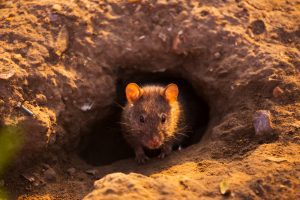10 REASONS WHY RATS CREEP US OUT!
By Chris Williams on February 7, 2018.

What is one man’s trash is many rats’ treasure! Shutterstock
1. Rats live in filthy places.
Home for a rat can be a sewer, dumpster, alley, or garbage dump where it might feed on animal or human feces, dead animals, or rotting garbage–and pick up germs in the process.
2. Rats carry diseases.
Maybe our primal fear of rats and disease goes back to the role of rats in the Black Death of the 1300s. Today, rats can transmit rat-bite fever, murine typhus fever, leptospirosis, and various food poisoning organisms to people and pets.
3. Rats poop everywhere.
An adult rat produces 50-60 pellet-like droppings in a day (more than 20,000 in a year), depositing them along its travel route, near food sources, wherever.
4. Rats contaminate the human food supply.
It’s estimated that 1/5 of the world’s produced food is either eaten or contaminated by rats’ droppings, urine, or hairs. One rat will eat 20-40 pounds of food in a year, 10-40% of its body weight in food each day.
5. Rats are disgustingly prolific.
A female Norway (brown) rat can have as many as 12 litters in a year, although 5 litters is more common. Each litter produces an average of 8-9 hairless pups that are independent in 3-4 weeks and sexually mature in 8 weeks.
6. Rats are at home in total darkness.
Rats are nocturnal animals. Although their eyesight is not great, they have a superb sense of touch. The very sensitive whiskers on their noses and the guard hairs on their bodies allow them to sense their surroundings and move around objects in the dark.
7. Rats can show up in toilets.
Norway rats are common in sewer systems and they’re good swimmers. They have been known to swim through sewer pipes and emerge in toilets. Rats can also get into toilets by entering the system through a roof vent.
8. Rats leave greasy smudge marks.
Rats follow the same travel routes or runways, often moving along baseboards or edges. The oils and dirt in their fur leave dark stains on walls and surfaces that they touch repeatedly.
9. Rats gnaw on wood.
Rats will also chew into other materials such as water pipes, vehicle wiring, gas lines, plasterboard, vinyl siding, even cinderblock. They spend about 2% of each day gnawing in order to make a bigger opening, get to a food source, or just because.
10. Rats’ burrowing causes damage.

Rat in burrow. Shuttersock
Rats like to dig their nest burrows under concrete slabs or other large, heavy objects and can undermine exterior walls, causing collapse. Their burrows damage roads, levees, sewer systems, and railroad tracks.